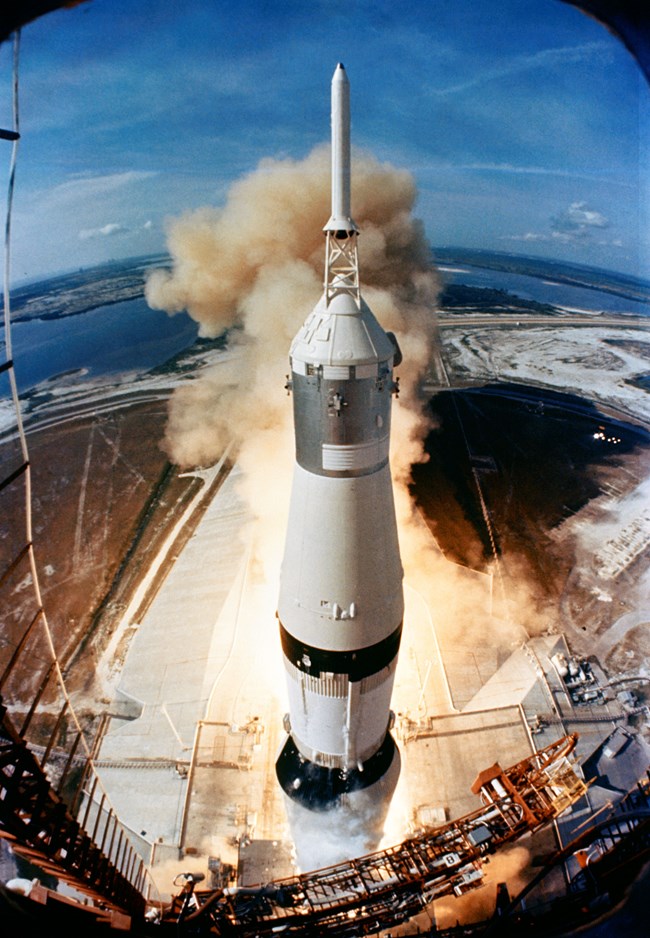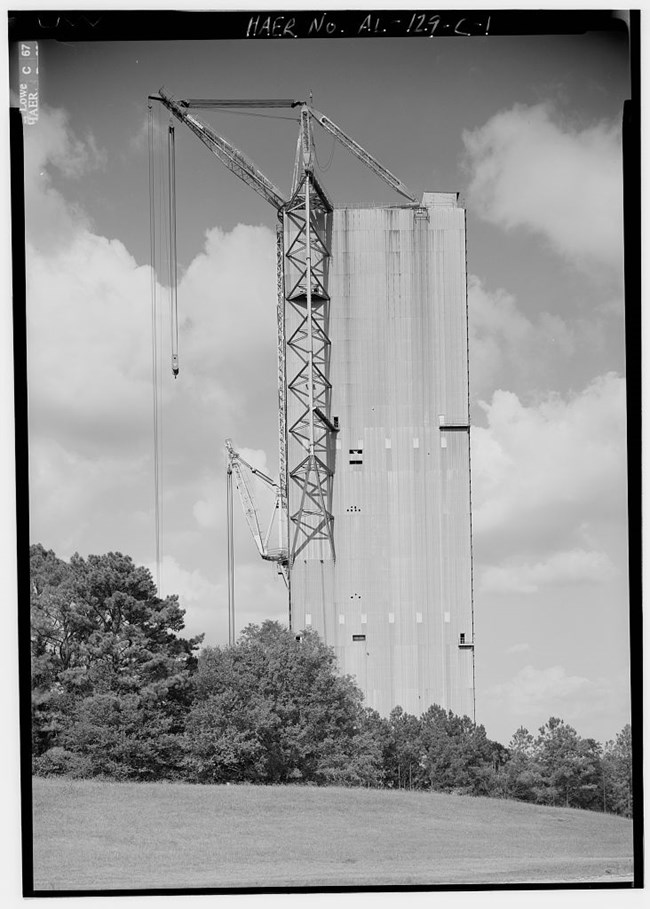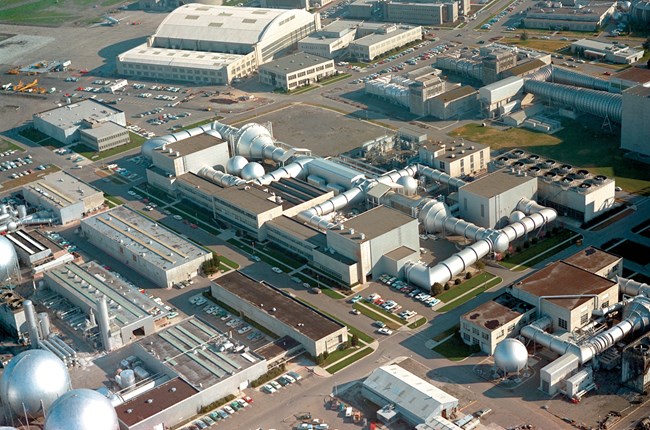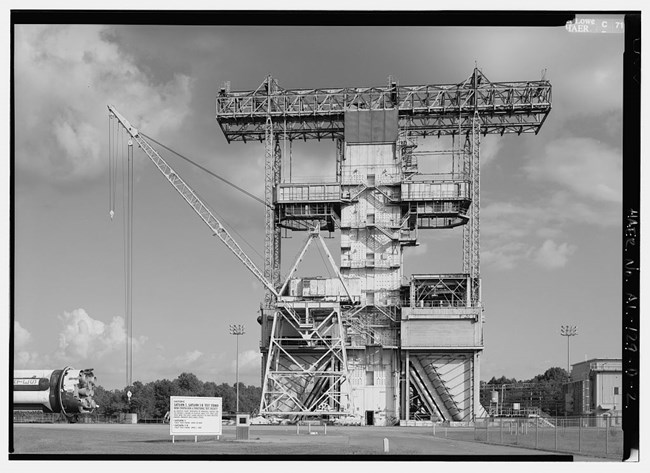Last updated: July 18, 2019
Article
Man in Space National Historic Landmarks
In 1985, the National Historic Landmarks Program published the Man in Space National Historic Landmark Theme Study to identify and recommend sites associated with the history of the manned space program. Featured prominently in that study are sites associated with the Apollo program, in particular Apollo 11. In celebration of the 50th anniversary of the Apollo 11 moon landing on July 24, 1969, we are featuring National Historic Landmarks that represent important milestones in American space exploration.
Saturn V Launch Vehicle

Courtesy of NASA.
In January 1962, the United States launched its attempts to achieve a manned lunar landing by developing the Saturn V rocket under the direction of Dr. Werner von Braun. Seven years later, a Saturn V lifted off with Neil Armstrong, Edwin Aldrin, and Michael Collins aboard, and carried them to their rendezvous with destiny. This first Saturn V was the test vehicle at the Marshall Space Flight Center and is identical to the one that put man on the moon. On display since 1969, the three-stage rocket is a featured exhibit at the U.S. Space and Rocket Center.
More on the Saturn V Launch Vehicle can be found in the Man in Space National Historic Landmark Theme Study.
Saturn V Dynamic Test Stand

Courtesy of Library of Congress, Prints & Photographs Division, HAER ALA,45-HUVI.V,7C-1.
The Apollo 11 moon landing in 1969—one of NASA’s greatest achievements—would never have happened without the careful testing of Saturn V rockets at the Saturn V Dynamic Test Stand in Huntsville, Alabama. The Dynamic Test Stand was the only NASA facility capable of testing a full-launch vehicle under dynamic launch conditions. Because of the testing that occurred here, no Saturn V ever failed in flight, and Apollo 11’s mission to the moon was successful. The Saturn V Dynamic Test Stand was designated a National Historic Landmark in 1985 for these contributions to the space program.
A number of Saturn V launches recently celebrated anniversaries, including the 45th anniversary of the last Saturn V launch on April 4, 1973. This launch was also the first Skylab mission, the first American space station.
More on the Saturn V Dynamic Test Stand can be found in the Man in Space National Historic Landmark Theme Study.
Unitary Plan Wind Tunnel

Courtesy of NASA Ames Research Center (NASA-ARC AC-38286-2)
By 1945, America began to lag behind German research in missiles and jet aircraft. The Unitary Plan Act, passed by Congress in October 1949, reinvested in the American aircraft industry and called for a coordinated national plan that combined the efforts of the National Advisory Council on Aeronautics (NACA), the Air Force, industry, and universities. The act also produced the Unitary Plan Wind Tunnel, which was completed in 1955. This system of three wind tunnels was able to test a full range of aircraft, from small planes to large missiles and quickly became a preeminent testing facility. All of NASA’s 1960s and 1970s manned space vehicles—including the space shuttle—were tested here.
The Unitary Plan Wind Tunnel was designated a National Historic Landmark in 1985. More on the Unitary Plan Wind Tunnel can be found in the Man in Space National Historic Landmark Theme Study.
Propulsion Structural Test Facility

Courtesy of Library of Congress, Prints & Photographs Division, HAER ALA,45-HUVI.V,7D-2.
Built in 1957, the Propulsion and Structural Test Facility is one of the oldest motor test facilities at the Marshall Space Flight Center in Huntsville, Alabama. It was designed to test Redstone, an American design that derived from the German V-2 rocket, and other rockets under development at the time at the Redstone Arsenal. When Project Mercury—the plan to place a manned capsule in orbital flight—was announced on October 7, 1958, the army pledged ten Redstone and three Jupiter vehicles to the project. These laid the successful foundation for the successful 1961 flights of Ham, the chimpanzee, on Mercury-Redstone (MR) 2 and Alan B. Shepherd aboard MR-3. Later, the Saturn S-1B vehicle and the F-1 engine for Saturn 1-C were tested here; these rockets supported the Apollo program. For its contributions to the development of large launch vehicles, the Propulsion and Structural Test Facility was designated a National Historic Landmark in 1985.
August 20, 2018, marked the 65th anniversary of the first launch of the Redstone missile at Cape Canaveral, marking a major milestone for American rocketry. More on the Propulsion and Structural Test Facility can be found in the Man in Space National Historic Landmark Theme Study.
